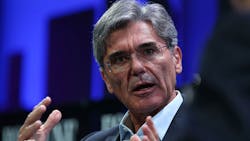Siemens AG posted strong second-quarter profit and outlined a plan to list its struggling power and gas division, a watershed moment in Chief Executive Officer Joe Kaeser’s drive to dismantle the company’s cumbersome conglomerate structure.
The shares surged the most in a year after the German company said adjusted earnings before interest, taxes and amortization from its main industrial business rose 7% to 2.41 billion euros (US$2.7 billion). That beat an average analyst estimate of 2.23 billion euros compiled by Bloomberg.
Order growth at the health-care Healthineers unit and strong returns at the digital factory division, which supplies plant-automation services, helped drive profits.
The plan announced Tuesday evening, a cornerstone of Kaeser’s strategic push to position Siemens for the future, would be the company’s biggest spinoff in its history. It also includes a decision to cut more than 10,000 jobs. Siemens rose as much as 4.7%, and was up 3.9% at 106.44 euros at 9:18 a.m. in Frankfurt.
“It’s about the next steps of a business that is fundamentally changing,” Kaeser told reporters in Munich. “The highest priority is the stabilization of a business that at its core is still feasible.”
The plan to list the energy division next year will be the latest in a series of de-consolidation moves by Kaeser after previously bringing the health-care division to market and merging the wind power unit with a Spanish competitor.
He also tried -- and failed -- to combine its train unit with French rival Alstom SA. The rail deal was blocked by European antitrust regulators. Revamping the company from a position of strength may help to head off the type of investor agitation that has plagued rival conglomerates such as General Electric Co. and Koninklijke Philips NV.
The carve-out “is a major step in the history of the company, as Siemens moves further toward a ‘break up’ scenario,” Morgan Stanley analyst Ben Uglow said in a note. “Management is doing what many companies struggle to do in more forgiving labor environments.”
Siemens will retain “somewhat less than 50%” of the new entity, which will include its 59% stake in Siemens Gamesa Renewable Energy, to create a company with 30 billion euros in business volume.
The division has operations spanning oil and gas as well as conventional power generation and transmission, while Siemens Gamesa develops wind farms and makes renewable energy equipment.
In addition to the structural revamp, Kaeser also unveiled job reductions at its core divisions to save about 2.2 billion euros by 2023. These include 4,900 cuts at digital industries, 3,000 at so-called smart infrastructure and 2,500 at its central corporate unit. At the same time, Siemens plans to hire about 20,500 new employees.
Gas and Power had the lowest profit margin of all divisions last year, according to figures that were revised to reflect the four wholly owned units Siemens created in an April 1 reorganization. A global collapse in turbine orders has also hit rival General Electric Co., contributing to the U.S. company’s deep slump.
Siemens had been looking at other options for the business. Bloomberg News reported in March that Mitsubishi Heavy Industries Ltd. was in talks with Siemens on a possible combination of the gas turbine business with its own operations, and that the German company also had discussions with other firms on a full or partial sale of the division.
What Bloomberg Intelligence Says
“Siemens’ proposed spinoff of its Gas & Power operations would remove a major impediment to its Vision 2020+ targets, but it faces a challenge garnering interest in a barely profitable business.” -- Johnson Imode, industry analyst.
In a statement, union representatives confirmed the options, saying the carve-out made the most sense for the labor representatives that make up half the supervisory board.
“In a joint venture with, for example, a Japanese competitor, we would have seen too great a risk,” Birgit Steinborn, chief employee representative on the supervisory board, said in the statement.
By Oliver Sachgau
About the Author
Bloomberg
Licensed content from Bloomberg, copyright 2016.
